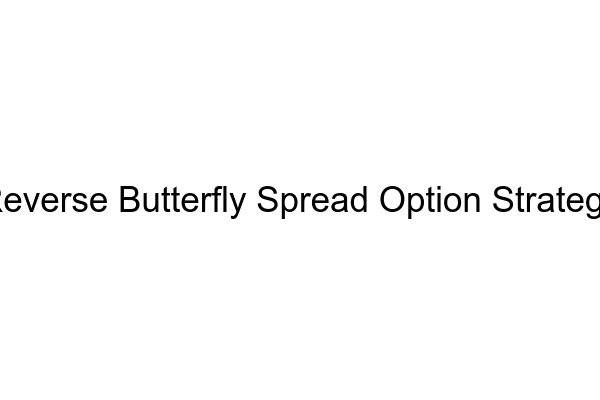Reverse Butterfly Spread Option Strategy

Reverse Butterfly Spread Option Strategy
What are the characteristics of this option strategy?
A reverse butterfly spread is an advanced directional options trading strategy that is used when the investor expects a large move in the underlying asset. This strategy is created by buying two at-the-money put options, selling one out-of-the-money put option and buying one out-of-the money put option. The maximum possible loss is the net debit paid and the maximum possible gain is the difference between strike prices of sold and bought option, minus the net debit paid.
Is this a bullish, bearish or neutral strategy?
This is a bearish strategy since it consists of more puts than calls.
Is this a beginner or an advanced option strategy?
This is an advanced option strategy due to its complexity. It is best suited for experienced traders who have a good understanding of the market conditions and the risk associated with this strategy.
In what situation will I use this strategy?
This strategy is best used when the investor expects a large move in the underlying asset. Typically, this strategy is used when the investor believes that the price of the underlying asset will move down significantly.
Where does this strategy typically fall in the range of risk-reward and probability of profit?
This strategy typically has a limited risk and unlimited reward potential. The maximum possible profit is the difference between strike prices of sold and bought option, minus the net debit paid and the maximum loss is the net debit paid. The probability of success varies depending on market conditions and other factors.
How is this strategy affected by the greeks?
Greeks play an important role in this strategy. Delta, gamma and vega are the most important greeks which need to be monitored closely. Delta measures the rate of change of option value with respect to the underlying asset’s price; gamma measures how delta changes with respect to the underlying asset’s price; and vega measures the rate of change of option value with respect to changes in implied volatility.
In what volatility regime (i.e VIX level) would this strategy be optimal?
This strategy is best used when the implied volatility for the underlying asset is high. Generally, when the implied volatility is high, the option prices are high and this helps to maximize the potential profit from the strategy.
How do I adjust this strategy when the trade goes against me? And how easy or difficult is this strategy to adjust?
If the underlying asset moves against the investor, the investor can adjust the strategy by buying one in-the-money put option and selling one out-of-the-money put option. This will reduce the risk of the strategy and lock-in some profits. However, this strategy is not easy to adjust and requires a good understanding of the market conditions.
Where does this strategy typically fall in the range of commissions and fees?
This strategy involves a lot of options and typically involves higher commissions and fees compared to other strategies. The higher commissions and fees can significantly reduce the profits of the strategy.
Is this a good option income strategy?
This strategy can be used as an option income strategy but it is best used as an advanced directional option strategy when the investor expects a large move in the underlying asset.
How do I know when to exit this strategy?
This strategy typically involves a limited loss and an unlimited upside potential; therefore, the investor should consider exiting the trade when the maximum profit is realized or when the investor’s risk tolerance is met.
How will market makers respond to this trade being opened?
Typically, market makers will try to ‘follow’ the investor’s trade in order to capture spreads. The investor should be aware that these market makers might try to exploit the option pricing structure of their trades.
What is an example (with calculations) of this strategy?
Let’s assume that the underlying asset is trading at $50; the investor buys two at-the-money (ATM) $50 put options for $2 each and sells one out-of-the-money (OTM) $55 put option for $1, and one OTM $45 put option for $0.50. The maximum possible profit is $3.50 (the difference between strike prices of sold and bought options minus the net debit paid i.e. $1.50) and the maximum possible loss is the net debit paid i.e. $1.50.
How MarketXLS Can Help
MarketXLS is a powerful and user-friendly Excel-based platform that offers sophisticated yet easy to use stock market analysis tools to all kind of individual investors. MarketXLS offers a portfolio of all-necessary analytics tools, such as options strategy scanner, live stock quotes, stock rating, backtesting, portfolio analytics, probability calculator and more. By using MarketXLS, you can analyze options strategies, set and monitor stock alerts, get market insights, and perform portfolio analysis. It has a wide range of options strategies, with Reverse Butterfly Spread Option Strategy being one of the strategies covered. MarketXLS is free, easy to use and very powerful.
Here are some templates that you can use to create your own models
Reverse Iron Butterfly Spread
Reverse Iron Albatross Spread
Search for all Templates here: https://marketxls.com/templates/
Relevant blogs that you can read to learn more about the topic
Are Butterfly Spreads Right for You?
Reverse Iron Butterfly Options Strategy (Using MarketXLS Template)
